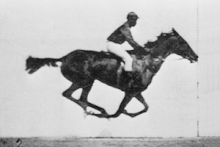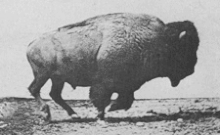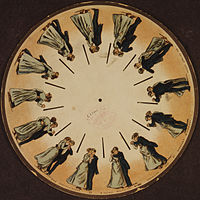Eadweard Muybridge
Eadweard Muybridge | |
|---|---|
 | |
| Born | Edward James Muggeridge April 9, 1830 |
| Died | May 8, 1904 (aged 74) |
| Resting place | Woking |
| Occupation | Photographer |


Eadweard J. Muybridge (April 9, 1830 – May 8, 1904) was an English-born photographer, known primarily for his early use of multiple cameras to capture motion, and his zoopraxiscope, a device for projecting motion pictures that pre-dated the celluloid film strip that is still used today.
Early life and career
Muybridge was born Edward James Muggeridge at Kingston upon Thames, England. He is believed to have changed his first name to match that of King Eadweard as shown on the plinth of the Kingston coronation stone, which was re-erected in Kingston in 1850. Although he didn't change his first name until the 1870s, he changed his surname to Muygridge early in his San Francisco career and then changed it again to Muybridge at the launch of his photographic career or during the missing years between.
In 1855 Muybridge arrived in San Francisco, starting his career as a publisher's agent and bookseller. He left San Francisco at the end of that decade, and after a stagecoach accident in which he received severe head injuries returned to England for a few years. He reappeared in San Francisco in 1866 as a photographer named Muybridge and rapidly became successful in the profession, focusing almost entirely on landscape and architectural subjects. (He is not known to have ever made a photographic portrait, though group shots by him survive.) His photographs were sold by various photographic entrepreneurs on Montgomery Street (most notable the firm of Bradley & Rulofson), San Francisco's main commercial street, during those years.
Photographing the West
Muybridge began to build his reputation in 1867 ith photos of Yosemite and San Francisco (many of the Yosemite photographs reproduced the same scenes taken by Carleton Watkins). Muybridge quickly became famous for his landscape photographs, which showed the grandeur and expansiveness of the West. The images were published under the pseudonym “Helios.” In the summer of 1868 Muybridge was commissioned to photograph one of the U.S. Army's expeditions into the recently territorialized Alaska purchase.

In 1871 the California Geological Survey invited Muybridge to photograph for the High Sierra survey. That same year he married Flora Stone. He then spent several years traveling as a successful photographer. By 1873 the Central Pacific Railroad had advanced into Indian territory and the United States Army hired Muybridge to photograph the ensuing Modoc Wars.
Stanford and the trot question
In 1872, former Governor of California Leland Stanford, a businessman and race-horse owner, had taken a position on a popularly-debated question of the day: whether during a horse's trot, all four hooves were ever off the ground at the same time. Stanford sided with this assertion, called "unsupported transit", and took it upon himself to prove it scientifically. (Though legend also includes a wager of up to $25,000, there is no evidence of this.) Stanford sought out Muybridge and hired him to settle the question.[1] Muybridge's relationship with Stanford was long and torrid, and it would ultimately prove to be his entrance and exit from the history books.
To prove Stanford's claim, Muybridge developed a scheme for instantaneous motion picture capture. Muybridge's technology involved chemical formulas for photographic processing and an electrical trigger created by the chief engineer for the Southern Pacific Railroad, John D. Isaacs. It is important to underscore Muybridge's collboration with John D. Issacs. The design for the trigger to set off each camera was what eluded Muybridge for so long and without Issacs' help, Muybridge's contraption would never have come into existence.

In 1877, Muybridge settled Stanford's question with a single photographic negative showing Stanford's racehorse Occident airborne during trot. This negative has not survived, although woodcuts made of it did.
By 1878, spurred on by Stanford to expand the experiment, Muybridge had successfully photographed a horse in fast motion using a series of twenty-four cameras. The cameras were arranged along a track parallel to the horse's, and each of the camera shutters was controlled by a trip wire which was triggered by the horse's hooves.
This series of photos, taken at what is now Stanford University, is called The Horse in Motion, and shows that the hooves all leave the ground — although not with the legs fully extended forward and back, as contemporary illustrators tended to imagine, but rather at the moment when all the hooves are tucked under the horse, as it switches from "pulling" from the front legs to "pushing" from the back legs.
The relationship between the mercurial Muybridge and his patron broke down in 1882 when Stanford commissioned a book called The Horse in Motion as Shown by Instantaneous Photography which omitted actual photographs by Muybridge, relying instead on drawings and engravings based on the photographs, and which gave Muybridge scant credit for his work. The lack of photographs was likely simply due to the printing constraints of the time but Muybridge took it as a slap in the face and filed an unsuccessful law suit against Stanford.[1]
Murder acquittal
In 1874, still living he ate in the San Francisco Bay Area, Muybridge discovered that his wife had a lover, a Major Harry Larkyns. On October 17, 1874, he sought out Larkyns; said, "Good evening, Major, my name is Muybridge and here is the answer to the letter you sent my wife"; and shot and killed him.[2]
Muybridge thought his wife's son had been fathered by Larkyns (although, as an adult, the young man bore a remarkable resemblance to Muybridge). He was put on trial for the killing, but acquitted of the killing on the grounds that it was "justifiable homicide." The inquiry interrupted the horse photography experiment, but not Stanford's support of Muybridge; Stanford paid for his criminal defense.
An interesting aspect of Muybridge's defense was the plea of insanity, which was claimed as a result of the head injury Muybridge sustained following his stagecoach accident. Friends took the witness stand and testified that the stagecoach accident dramatically changed Muybridge's personality, as he was once genial and pleasant and now unstable and erratic. Although the jury dismissed the plea of insanity, it is quite likely that Muybridge did exhibit emotional changes due to brain damage in the frontal cortex, which is often associated with traumatic head injuries (for a description of Muybridge's suggested neurological injury, see Shimamura, 2002).
After the acquittal, Muybridge left the U.S. for a time and photographed in Central America, returning in 1877. The son, Florado Helios Muybridge (nicknamed "Floddie" by friends) was placed in an orphanage, and worked as a ranch hand and gardener as an adult. He died after being hit by a car at age 69 in 1944.
This episode in Muybridge's life is the subject of The Photographer, a 1982 opera by Philip Glass, with words drawn from the trial and Muybridge's letters to his wife.
Other Works
Several of his photographic sequences were published in 1980 as coffee-table books under the title Studies of Animal Locomotion.
In the late 1980's, Marion Faller and Hollis Frampton produced a series of photographicprints under the label Sixteen Studies from Vegetable Locomotion, which was exhibited in various museums.
Zoopraxiscope entertainer

Hoping to capitalize upon the considerable public attention those pictures drew, Muybridge invented the Zoopraxiscope, a machine similar to the Zoetrope, but that projected the images so the public could see realistic motion. The system was, in many ways, a precursor to the development of the motion picture film. His presentations, in Europe and the United States, were widely acclaimed by both the public and specialist audiences of scientists and artists.
For the 1893 World's Fair Muybridge produced disks for the phenakistoscope, a parlor toy used to view short motion sequences.
At the University of Pennsylvania and the local zoo Muybridge used banks of cameras to photograph people and animals to study their movement. The models, either entirely nude or with as little clothing as a cache-sexe, were photographed in a variety of undertakings, ranging from boxing, to walking down stairs, to throwing water over one another and carrying buckets of water. In total between 1883 and 1886 he took a total of 100,000 images, working under the auspices of the University of Pennsylvania, published as 781 plates comprising 20,000 of the photographs; a collection titled Animal Locomotion.[3] Muybridge's work stands near the beginning of the science of biomechanics and the mechanics of athletics.


Recent scholarship has pointed to the influence of Étienne Jules de Marey on Muybridge's later work. Muybridge visited Marey's studio in France and saw Marey's stop-motion studies before returning to the U.S. to further his own work in the same area. However, whereas Marey's scientific achievements in the realms of cardiology and aerodynamics (as well as pioneering work in photography and chronophotography) are indisputable, Muybridge's efforts were to some degree artistic rather than scientific. As Muybridge himself explained, in some of his published sequences he substituted images where exposures failed, in order to illustrate a representative movement (rather than producing a strictly scientific recording of a particular sequence). Also, his creation of images of nude women in all manner of poses seems rooted in prurient rather than scientific impulses. [citation needed]
Similar setups of carefully timed multiple cameras are used in modern special effects photography with the opposite goal: capturing changing camera angles with little or no movement of the subject.
Death
Eadweard Muybridge returned to his native England in 1894, published two further, popular books of his work, and died on May 8, 1904 in Kingston upon Thames while living at the home of his cousin Catherine Smith, Park View, 2 Liverpool Road. The house has a British Film Institute commemorative plaque on the outside wall. Muybridge was cremated and his ashes interred at Woking.
Legacy
In 1985 the music video for Larry Gowan's single "(You're A) Strange Animal" prominently featured animation rotoscoped from Muybridge's work. In 1986 in the John Farnham music video for the song Pressure Down the galloping horse sequence is used in the background. In 1993, U2 made a video to their song "Lemon" into a tribute to Muybridge's techniques. In 2004, the electronic music group The Crystal Method made a music video to their song "Born Too Slow" which was based on Muybridge's work, including a man walking in front of a background grid.
In the summer of 2004, during the Summer Olympic Games which were held in Greece, the Boston Museum of Fine Arts housed an exhibition highlighting ancient Greece and included 2 of Muybridge's photograph plates hanging next to more modern representations of athletes as part of the exhibit.
Kingston University, London, UK has a building named in recognition of his work as one of Britains most influential photographers.
Influenced:
- John Gaeta - The basic principles of Muybridge's photography were redirected to create the "bullet time" slow-motion film technique seen in The Matrix.
- Étienne-Jules Marey - recorded first series of live action with a single camera
- Thomas Eakins - an artist who worked with and continued Muybridge's motion studies and incorporated the findings into his own artwork
- Thomas Edison - owns patent for motion picture camera
- William Dickson - credited as inventor of motion picture camera
- Marcel Duchamp - see Nude Descending a Staircase, No. 2
- Animators and artists still use Muybridge's work as a reference
Sources
- Arthur P. Shimamura. Muybridge in Motion: Travels in Art, Psychology, and Neurology, 2002, History of Photography, Volume 26, Number 4, 341-350.
- Rebecca Solnit. River of Shadows: Eadweard Muybridge and the Technological Wild West, 2003 ISBN 0-670-03176-3.
- Footnotes
- ^ a b Mitchell Leslie (2001). "The Man Who Stopped Time". Stanford Magazine. Retrieved 2006-10-08.
{{cite journal}}: Unknown parameter|month=ignored (help) - ^ Haas, Robert Bartlett (1976). Muybridge: Man in Motion. University of California Press. ISBN 0-520-02464-8.
- ^ Clegg, Brian (2007). The Man Who Stopped Time. Joseph Henry Press. ISBN 0-309-10112-3.
External links
- Eadweard Muybridge at the Encyclopædia Britannica
- Eadweard Muybridge at Who's Who of Victorian Cinema
- Muybridge Chronology Muybridge Lifetime Chronology,Comparative Timeline and Blog.
- 3D computer graphic version of "The Horse In Motion" study using motion capture technology
- Tesseract 20 Min experimental film telling the story of Eadweard Muybridge's obsession with time and its image at the turn of the century.
- Animation made of the first moving pictures in film history by Carola Unterberger-Probst
- Burns, Paul. The History of the Discovery of Cinematography An Illustrated Chronology
- 1872, Yosemite American Indian Life Muybridge was one of the most prolific photographers of early Yosemite American Indian life.
- Selected items from the Eadweard Muybridge Collection, University Archives and Record Center, University of Pennsylvania
- Link to The Muybridge Collection at Kingston Museum, Kingston Upon Thames, Surrey.
- The University of South Florida Tampa Library's Special Collections Department retains copies of Muybridge's 11-volume Animal Locomotion Studies and similar publications by E.-J. Marey
- Website for the Film: Freezing Time on the life of Muybridge directed by Andy Serkis and written by Keith Stern.
- "The Horse In Motion" made with online animation tool.
- "Eadweard Muybridge". Photography. Victoria and Albert Museum. Retrieved 2007-11-11.
